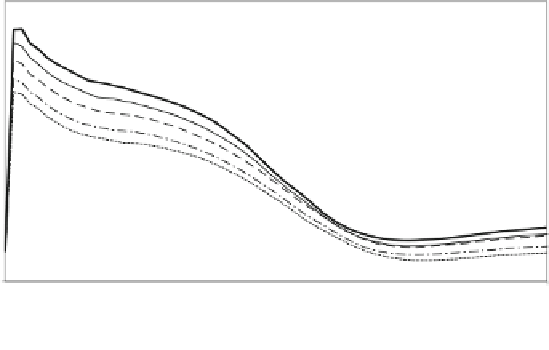Geoscience Reference
In-Depth Information
1.18
1.16
Ageing
Retire 66
Retire 67
Retire 68
Retire 69
1.14
1.12
1.10
1.08
1.06
1.04
1.02
2005
2010
2015
2020
2025
2030
2035
2040
2045
2050
2055
2060
2065
2070
65
66
67
68
69
Fig. 11.13
Extending retirement age and the impact on wages
Simulations for impact analysis are conducted through the four scenarios, which
are differentiated by retirement age. It is assumed that the retirement age is delayed
by 1 year for each Scenario, i.e., for Scenario 1 through 4, individual is supposed
to retire at 66, 67, 68, and 69, respectively. Once again, the baseline scenario is one
in which the population ages as before. Increasing the retirement age generates a
smaller capital/labor ratio compared to Baseline Scenario since the labor force
increases as much as the working age is expanded. The lower capital/labor ratio
leads to a fall in wages as shown in Fig.
11.13
. According to the simulation results,
if the retirement age is delayed by 4 years, i.e., retirement at the age 69, then wages
fall by 7 ~ 8 % until 2030s compared to the baseline. Figure
11.14
shows what
happens to the per capita GRP. Basically, the rise in the retirement age contributes
to an increase the output, and thus the per capita GRP also increases since there is
no change in the size of population. In particular, if individuals could continue
working beyond the age 65 by at least 2 or 3 years longer, then the per capita GRP
around 2050s starts to rise above the level before the ageing population occurs.
However, the additional gain in per capita GRP corresponding to a 1-year increase
in retirement age becomes smaller, reflecting the fact that the productivity of
population decreases dramatically from age 65.
There is also an impact on social security tax rates. Not surprisingly, there is a
marked decline in social security tax rate over the transition period. For example,
the maximum tax rate around 2030s decreases from 11 % in the Baseline Scenario
to below 6 % in Scenario 4, which is even lower than before the ageing population.
The significant fall in tax rate becomes possible thanks to both increases in pension
contribution by increased working-age populations and delay in the payment of
pension benefits.
There is a small effect from increasing retirement age on income and asset
distribution. The Gini coefficients for both cases appear to increase, though not
noticeably, over the entire transition period as the retirement is delayed to the later
age. This result is consistent with expectations suggested by transitional paths of








































